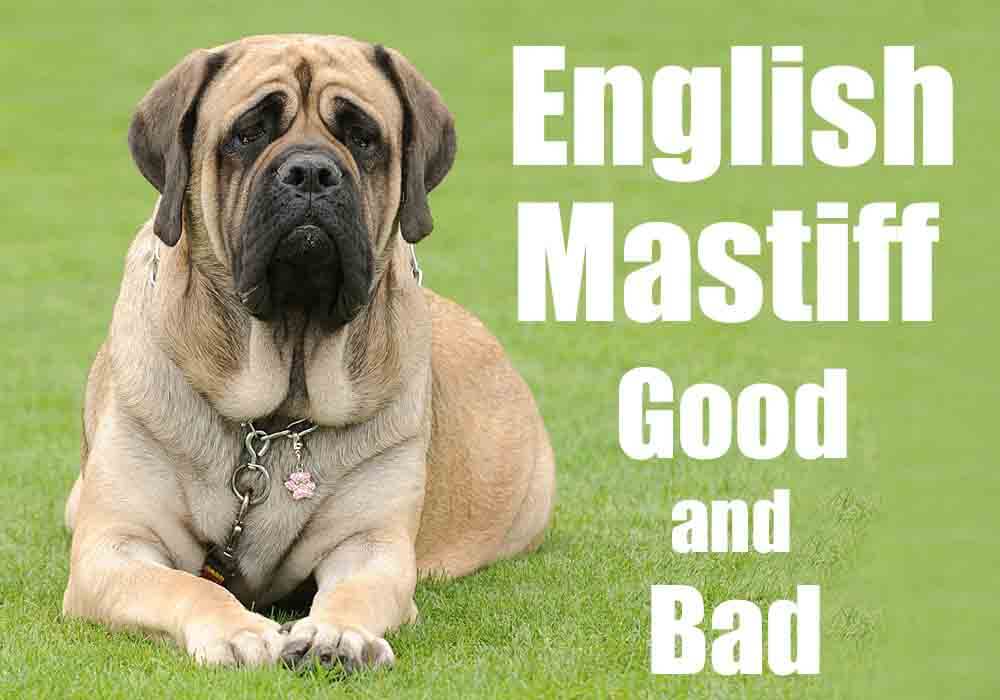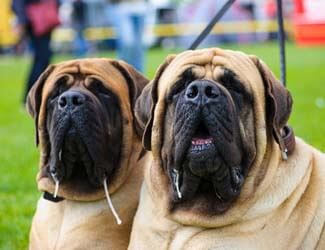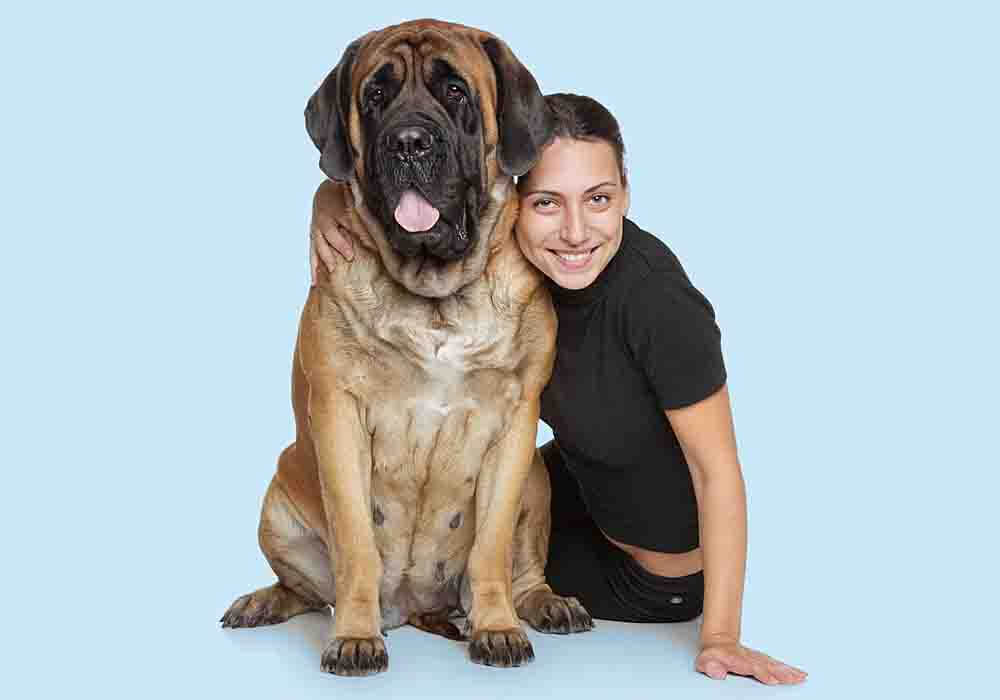English Mastiff Good
and Bad
12 Pros and Cons About This Breed
by Ken Alden
Despite their
size and sometimes intimidating bark, the English Mastiff has built a reputation of
being one of the most gentle and loyal family dogs around.
English Mastiff Good And Bad To Consider...
The Good:
- They don’t need much exercise
- They’re easy to train
- They’re loyal
- They’re social
The Bad:
- They shed a lot
- They drool a lot
- They’re prone to health issues
- They’re expensive to care for
We want to make sure that you know all of the pros, cons, and the in-between when it comes to owning an English Mastiff. That way, you can make a more informed decision and decide if this is really the right breed for you! So let’s dive right into it….Read More Below
Pro-tip: Ever try lifting an English Mastiff? Their weight can hurt not only your back but their joints when they hop down from cars, sofas or even your bed. To protect your back and theirs check out the best Mastiff ramps on Amazon.com now.

English Mastiff - What’s Good About Them
There’s no doubt that the English Mastiff is a great dog breed. They’re the perfect breed if you just like to hang around the house or invite friends over for the big game. They learn new rules rather quickly, even though they can sometimes be a little stubborn.
They don’t make all that much noise unless you’re bothered by the sound of a 150-pound dog sleeping beside you. This dog will let you know if the family is in danger and keep a close eye on your kids, their new best friends.
Here’s 6 points to
consider…
English Mastiffs don’t require much exercise...
The English Mastiff is actually a pretty lazy dog breed! That makes them the perfect fit if you love to lounge around the house and chill out on the couch. In fact, they’d probably rather cuddle up with you in bed than go for a long walk.
However, they do appreciate some exercise during the day, though they don’t do well with intense exercise. That’s because there are plenty of physical restrictions for this breed because of its huge size, weak joints, and incredible mass.
To get the English Mastiff active, you should be okay with about an hour of exercise per day, or about two 30 minute walks. This pooch also might be up for a casual jog or hike at the local park, though low-speed would be the best option.
Even if your pooch wants to continue
playing, you need to keep an eye on how his body’s reacting to the exercise. If
you notice that he’s drooling a lot or limping, you should bring him outside
and give him some time to rest.
Regardless of their minimal need for exercise they still do need some. We explore this exercise topic as well as offering some great exercise tips for just his breed.
English Mastiffs are relatively easy to train...
Though the English Mastiff appears to be a
dominant dog breed, it’s really not too hard to train them. That’s because they love to please their owners
and will do anything to impress you, especially when it comes to learning new
skills and commands.
What makes training even easier of this dog is
it’s love of food rewards. So, keep a bag of tiny treats on hand, and you’ll be
able to keep them under control, even when they grow larger than 100 or 200
pounds.
The English Mastiff is great with training, but you need to keep training sessions short and to the point. Try your best to begin daily training sessions (about 15 minutes each) starting when your English Mastiff is about two months old.
Given the sheer size of this dog,
it’s important that you teach them to socialize properly with other dogs and
people. You want your Mastiff to nicely approach new people and dogs without
scaring them off with a friendly lunge or an excited bark.
When it comes time for training there are multiple things to keep in mind. We lay them all out as well as offering some great tips to make the job easier with our Mastiff training tips page.
English Mastiffs are very loyal to their families...
One of the most sought after traits of this breed is its incredible sense of loyalty. Once it builds a relationship with its family and close friends, it’ll do whatever it can to keep them safe from any outside threats.
Your dog will be so loyal, however, that he might relentlessly follow you around the house and give off a clingy vibe. It might be annoying at first, but when you realize he’s doing it because he loves you, it’ll actually seem really sweet.
The English Mastiff was bred to be protective, not aggressive. So, they’re much more likely to warn you of danger and try to get in between you and a stranger than actually try to intervene in a confrontation.
It’s really common for this breed to growl at
threats. But, what makes the breed really stand out is how it uses its physical
size to protect its family. Your English Mastiff might stand between you and a
stranger and warn them to keep their distance from you!
Pro-tip: English Mastiff anxiety, aggression, destructive chewing, jumping up, fearfulness, and other behaviors can be controlled with the right training program.
Here’s a great course that
addresses these issues along with many other dog training basics: Check it out now!
English Mastiffs are very social dogs...

The English Mastiff is considered a gentle giant. Rather than running around and playing outside, your English Mastiff would rather spend some time in the air conditioning indoors and just spend time with you.
Though clearly not a lap dog in terms of its size, it is is known for being very affectionate. It wouldn’t be unusual for your pal to hop onto the couch and cuddle up with you (though your legs might go numb).
This breed hates to be alone and would much rather be with his human friends. So much so, in fact, that this breed is incredibly prone to developing separation anxiety. Here’s a look at what might happen if you leave your English Mastiff alone for too long:
- Chewing habits (chair legs, furniture, pillows, door frames, etc.)
- Tearing the house apart
- Anxious pacing
- Inappropriate bathroom relief indoors (urination and defecation)
- Excessive barking
English Mastiffs are great with kids...
Even though you might be a little nervous about leaving your 200-pound English Mastiff with a toddler or baby, this breed is actually really good with kids. When they recognize these new small humans are part of their family, they welcome them with open arms.
This breed is extremely tolerant of the common behaviors of children. They’ll put up with a lot, whether your kid accidentally pulls your Mastiff’s tail, tugs on his ears, or pushes into him when trying to wrestle.
The greatest issue is the size difference. Even though your English Mastiff would never intentionally hurt your child, there’s always the possibility that he might knock your kid over when playing or simply walking by.
Supervising the interaction is a great first
start. But, you might want to wait until your kids get a little older before
you bring a new English Mastiff puppy home. The breed does much better with
older children, and it’s much less of a safety issue.
English Mastiffs are pretty quiet dogs...
This breed definitely has a pretty intense bark, but it’s very rare that you’ll actually hear this breed bark once they’re adults. Once you teach them that barking isn’t appropriate in the home, they usually catch on pretty quick and leave that behavior for emergencies only.
So, what makes an English Mastiff actually bark? Well, the most common reason they bark is that they haven’t been trained not to. But, even the most well-trained English Mastiffs will send off an alert bark if he feels there’s an intruder or danger to the family.
The barking typically fades away when your dog gets older. What doesn’t disappear, however, is the intense snoring that’s common in most English Mastiffs. This is because this dog is considered a Brachycephalic breed.
This type of breed simply means that they have
a shorter snout, which can impact their ability to breathe slightly. So, it’s
almost impossible for your pooch to take a quick nap without the whole house
knowing he’s sleeping.
Pro-tip: English Mastiff's (and their owners) love dog crates…and for good reasons. Crates keep dogs from mischief while you're away, are perfect for house training, for traveling by car, and provide the dog a place to de-stress. Check out the best Mastiff crates on Amazon.com now.
English Mastiff - What’s Bad About Them
This breed isn’t the best choice if you want a dog that doesn’t require a ton of grooming or clean-up. This breed sheds like crazy (especially during the spring and fall) and drools like that’s its day job. Despite how cuddly they are, they tend to be intimidating to the outside world.
The biggest downside of the English Mastiff is its health issues. They’re much more prone to being overweight and developing expensive-to-treat conditions like hip dysplasia and bloat. Plus, tack on the extra cost of feeding this dog an insane amount of food on a daily basis.
Here’s 6 points to consider…
English Mastiffs shed a ton...
The actual hair of the English Mastiff is pretty short, but don’t let that convince you that they don’t shed. This breed is actually one of the worst offenders when it comes to just how much they shed.
The reason they shed so much is that they have a double coat. This coat is designed to give the breed a little extra protection in extremely hot and extremely cold weather. But, it also means that the coat will “blow” twice a year in the spring and the fall.
When this “blowing” occurs, the undercoat begins to fall out in clumps. And, the larger the English Mastiff, the more hair there is to shed! This breed sheds year-round, so it’s best to keep up with grooming on a daily basis.
The best thing you can do is to make sure you brush your dog’s coat on a daily basis. Deshedding tools are even better for digging deep into the thick undercoat to get rid of any loose hairs too.
Since owners can't stop their dogs shedding, there are ways to better control it. We offer some great tips that can make it more bearable.
English Mastiffs drool quite a bit...

Think about the massive size of the English Mastiff! They can sometimes weigh over 200 pounds, but the issue isn’t really in their weight. It’s actually in the structure of their mouth: Their loose lips!
Because the English Mastiff’s lips aren’t able to hold back any excess drool and saliva, the breed always seems to be drooling. They most often drool when they get hungry, when they drink water, or when they exercise a little too much.
Even though there’s nothing you can do to stop the drooling permanently, there are some things you can do to deal with it as it happens. It’s always best to have some small towels handy to wipe up your pal’s drool piles after dinner.
But you can also be even more proactive. Dog bibs are great for catching the drool as it drips out of the English Mastiff’s mouth, and rugs under the food bowl can keep your kitchen floors clean and dry.
We've come up with a helpful page offering even more drool control ideas. No, you can't stop it, but with these tips it's make things more manageable.
English Mastiffs are prone to health issues...
The larger a dog is, and the more it weighs, the more likely it is to develop health conditions. When it comes to the English Mastiff, there are a few health conditions that are much more common. Here’s a look at these conditions.
- Hip Dysplasia. This condition occurs when the hip joint doesn’t work properly. Rather than gliding smoothly, it begins to grind on the bone. This can make walking extremely painful and cause your English Mastiff to develop a limp. The condition is even worse in overweight dogs.
- Bloat. This condition is also called Gastric Dilatation and Volvulus (GDV). When this occurs, the stomach fills up with too much gas and food and actually flips over. When this happens, the gas builds up even more, and it can prove to be fatal. The more a dog eats in one sitting, the more likely bloat will occur.
Even though you can’t prevent joint conditions
like hip dysplasia entirely, there are some preventative strategies. The best
thing you can do is add glucosamine and chondroitin to your English Mastiff’s
diet to encourage greater joint repair and strength.
Because of the large veterinarian expenses that comes with the health issues that come with this breed many owners opt for pet insurance which can be a wise choice particularly for large dogs.
We review the top 3 insurance carriers to see which one offers the best deals at the most reasonable rate. Check out our review here.
English Mastiffs are expensive to care for...
The cost of treating health conditions like bloat and hip dysplasia can run you several thousand dollars each! Yet, a lot of the cost that comes with owning this breed is the amount of money you’ll be spending on food and supplements.
A big dog that can weigh over 200 pounds needs to be eating a lot of food on a daily basis. For some English Mastiffs, this means eating about two pounds of food a day, and even more if your dog is larger.
Even if you lean toward some of the cheaper food options, you still might be looking at at least $30 a week just to feed your Mastiff. Buying higher-quality food and wet food will be even harder on your wallet.
But, since this dog has relatively
weak joints, you should be giving your English Mastiff joint supplements on a
daily basis. These can be another $30 or more a month. Plus, given the size of
your English Mastiff, he’ll need more than one a day, which eventually adds up.
Ever wonder how expensive feeding a Mastiff really is? We've sharpened our pencils and bit into this further. We think you'll be surprised what the yearly costs really are.
English Mastiffs seem to intimidate people...
You know how nice and cuddly your English Mastiff is, but a dog of this size tends to be intimidating to the outside world. So much so, in fact, that it wouldn’t be uncommon for people to back away when your pooch approaches.
This dog can weigh over 200 pounds and measure in at around 32 inches at the shoulders. Considering the fact that this breed tends to weigh more than the average American, it’s no surprise that others are so wary of this dog.
The major downside of owning a Mastiff is its reputation. Since it's so large and news stories about aggression tend to be major headlines, you might be restricted when it comes to where you can live with this type of dog.
Many apartment complexes in the United States
ban dogs like Mastiffs, Pitbulls, and even Huskies. So, you need to make sure
that your apartment complex or townhouse development doesn’t have any size or breed
restrictions before bringing your English Mastiff puppy home.
English Mastiffs have a relatively short lifespan...
According to the American Kennel Club, the average lifespan for the English Mastiff is between 6 and 10 years. That’s because larger dogs tend to age much more quickly, as compared to much smaller breeds.
Because of this, breeds like the English Mastiff are much more likely to experience bone and joint issues much sooner. Tack on the extra weight this breed is lugging around, and you’ll understand why their lifespan is what it is.
Here are some other things that might impact your English Mastiff’s lifespan.
- Weight. The healthier the weight, the less likely they are to develop obesity-related joint conditions like hip dysplasia.
- Frequent vet visits. Yearly checkups and sick visits are a great way to keep track of your English Mastiff’s health and catch any diseases sooner rather than later.
- Supplements. Joint supplements are a great way to prevent or reduce the symptoms of common English Mastiff joint conditions.
- Vaccinations. This should be mandatory. This is the best way to prevent the preventable conditions like rabies and distemper.
English Mastiff good and bad...final thoughts
Even though the Mastiff is intimidating to the outside world, that doesn’t mean they’re scary or dangerous dogs. They’re usually very loving and loyal to their own families. Here are some of the most important things to consider before getting an English Mastiff.
- How active your family is (English Mastiffs like to hang around and relax, but don’t like to be alone for too long)
- Whether you want a dog that’s easy to train (They are great learners)
- If you need a guard dog (This breed is loyal, but won’t do well at guarding...think of them as more of watch dogs)
- How much you’re willing to spend on a dog (They are
very expensive to own)
Return To The Top Of This English Mastiff Good And Bad Page

About the Author...
Ken Alden, a dedicated Mastiff owner for over eight years, is acclaimed for his expertise in care, grooming, and training. Read more About Me and my dog Shadow.
- Mastiff Guide Home ›
- English Mastiffs ›
- English Mastiff Good And Bad






